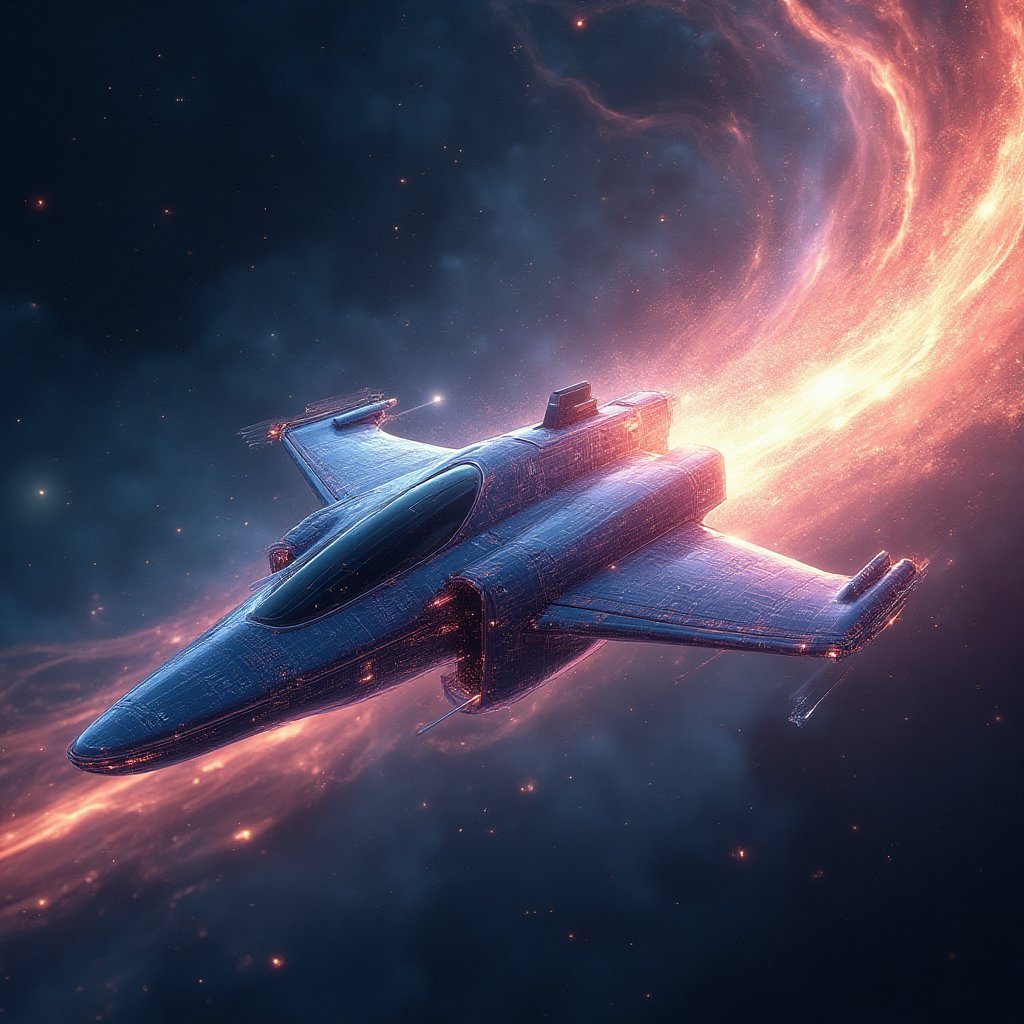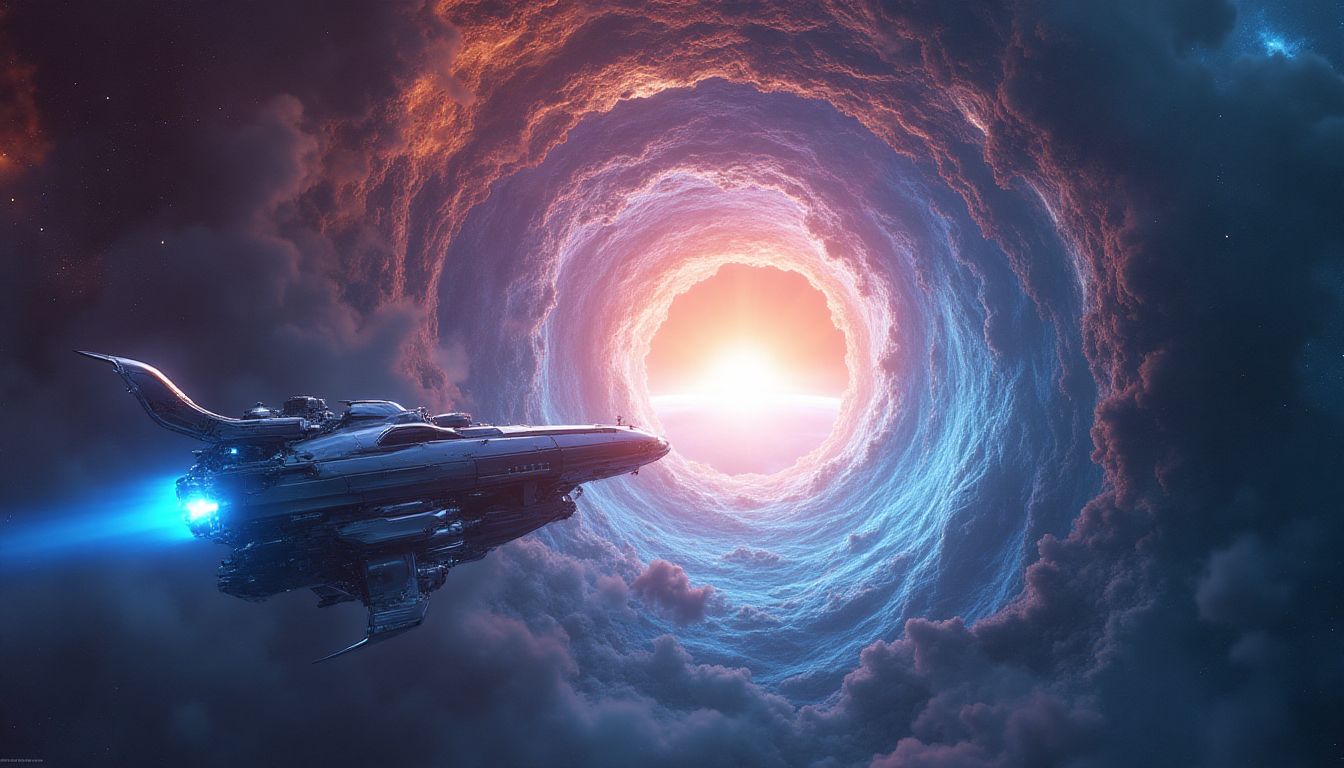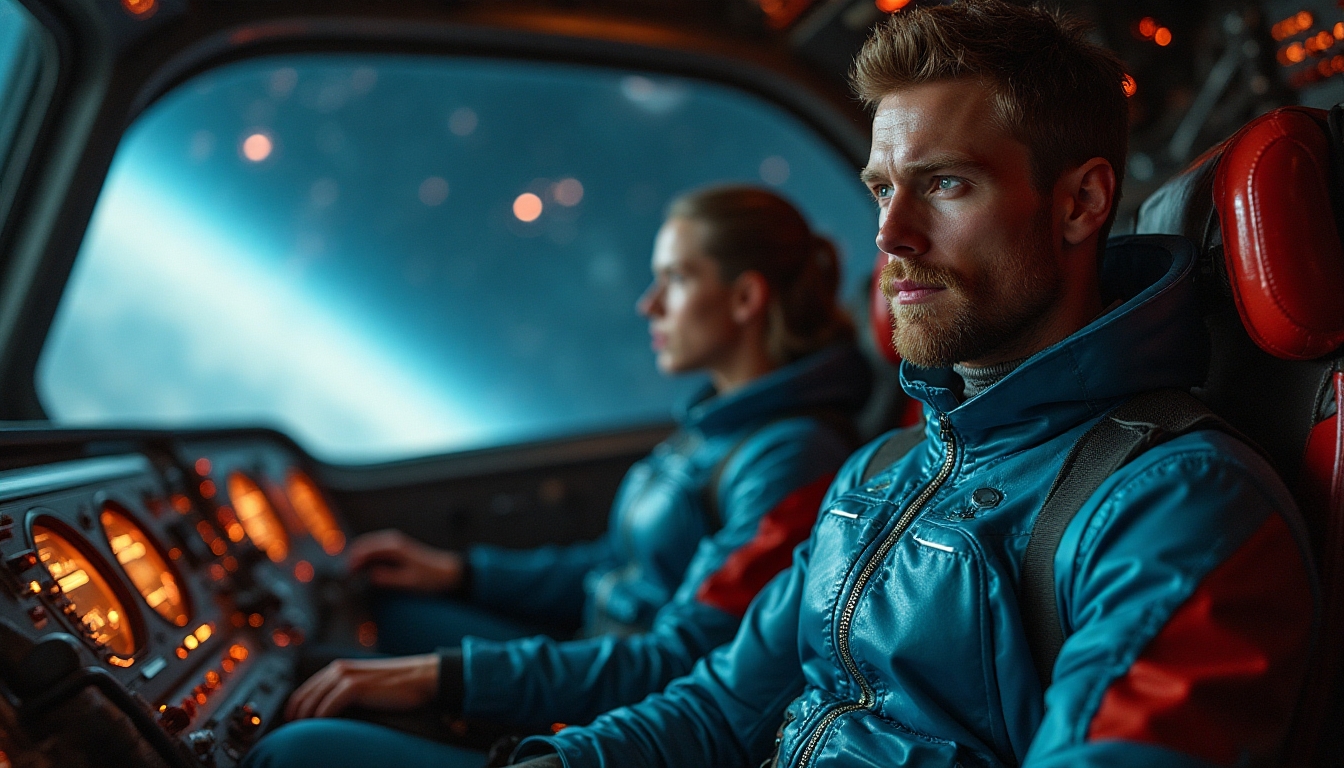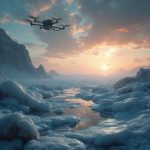Introduction: The Future of Space Travel is Now
It is not by muscle, speed, or physical dexterity that great things are achieved, but by reflection, force of character, and judgment. — Cicero. This ancient wisdom tells us that great feats aren't achieved by physical strength alone—it's the imagination, character, and critical thinking that push boundaries. As we gaze up at the stars, pondering what lies beyond, it becomes clear that the key to unlocking cosmic secrets and transporting ourselves to the farthest reaches of the universe might not lie in propulsion rockets alone, but in the realms of artificial intelligence and groundbreaking theories.
Could our fascination with faster-than-light (FTL) travel, spurred on by iconic series like Star Trek, transform from science fiction to reality with the help of AI? It might sound as wild as landing a taco on the moon, but in an era where technology and imagination converge, nothing seems too out of reach. Delve into the realms of space folding, examining how AI-driven advancements could be the catalyst for a new era of exploration.
Theoretical Foundations of Faster-Than-Light Travel
The concept of faster-than-light travel captivates curious minds, setting the stage for discussions that stretch across realms of physics and imagination. It's as intriguing as wondering if cats have secret lives or if socks teleport when they vanish from the dryer. However, this curiosity isn't just a whimsical dream—it's grounded in the fabric of theoretical physics.
Visionaries like Michio Kaku and Stephen Hawking have contributed significantly to discussions on the nature of the universe and its ultimate possibilities. Kaku, known for his works on the physics of the impossible, poses questions that resonate with our fascination of FTL travel, while Hawking's insights into black holes and the cosmos inspire explorers, young and old, to seek the stories hidden within the universe's whispers. Literary luminary Isaac Asimov with his prolific science fiction writings, also ignites the imagination by blending scientific possibility with human curiosity.
From Einstein and his theory of relativity to modern-day concepts like wormholes and warp drives, our understanding of space and time is constantly evolving. Einstein's theories, while mind-boggling, paint a picture that the universe is far more malleable than initially thought. Space folding, a brainchild of theoretical physics, proposes the potential to create shortcuts through the vast distances of space—a concept that may one day serve as the launchpad for humanity's grandest voyages.
Like trying to fold a fitted sheet, the science of space folding presents fascinating yet complex challenges. Imagine the universe as a sprawling fabric; the task is simple: fold it, and maybe, just maybe, we'll leap from one side to another in a cosmic heartbeat.
Current Technologies and Paradigms
It's an enthralling time for space enthusiasts as today's technological breakthroughs feel like seeds sown in space gardens of the future. Yet, before we ride the FTL waves, we need to anchor ourselves in the current reality of technology. Understanding the technological canvas currently available is like learning to crawl before a sprint. Let's dive into the machinery of progress!
Breakthroughs in Propulsion Systems
Propulsion systems are the backbone of our space endeavors. While we've yet to scream past the light-speed barrier, some exciting advancements are sashaying their way into the spotlight like stars on the Oscars' red carpet. Ion propulsion, for instance, is a nifty piece of technology that might not make the Kessel Run in less than twelve parsecs, but it’s more fuel-efficient. NASA is paving the way with the Solar Electric Propulsion project, transforming the mechanics of space travel. Then there's nuclear thermal propulsion, offering the promise of reduced transit time to our cosmic next-door neighbor, Mars. Companies like Ultra Safe Nuclear Technologies are exploring this energy-dense avenue. Let's not forget the scintillating whispers of fusion propulsion, a dream of the textbooks now inching towards reality. Even in the nebula of propulsion systems, it seems the sky may not be the limit!
The Role of Quantum Physics
Ah, quantum physics – where particles play peekaboo and logic takes interdimensional leaps. This domain holds tantalizing clues for FTL travel, flipping through the pages of physics with fervor. Enter quantum entanglement, an exclusive party for pairs of particles promising instantaneous communication across light years. The implications for FTL? Let's just say Einstein might be doing a slow clap somewhere. Quantum tunneling, too, teases a future of particles breaking barriers with finesse akin to a magician pulling a rabbit out of a hat. It's no wonder scientists at institutions like Max Planck Institute keep finding treasure troves in the quantum realm, no less intriguing than a sci-fi novel! While quantum mechanics may feel like a riddle wrapped in an enigma, its promise continues to beckon space pioneers.
The Role of AI in Scientific Discovery
Now here's where the narrative takes a sharp turn into exhilarating terrain! Artificial intelligence isn't just revolutionizing industries; it's playing the role of space consultant too. Who knew silicon-based brains would be our co-pilots in the cerebral pursuits of science? If FTL travel is the thriller of tomorrow, AI bolsters the plot with its relentless algorithms. Let's have a gander at the key characters in this scientific drama!
Machine Learning and Computational Models
Machine learning is essentially AI's equivalent of a sudoku – numbers just make sense! When powered by complex computational models, AI can transform convoluted data into elegant theories. These digital sleuths can sift through data mountains, extracting insights like a gold miner finding nuggets in a stream. Researchers at institutes like OpenAI are giving AI capabilities that make Avengers envious. Furthermore, AI simulations enable virtual labs where theories about FTL travel are tested without leaving Earth’s atmosphere. It’s almost as if AI's computational cogwheels are drafting the scripts for cosmic exploration!
AI’s Contribution to Problem Solving
If problems are the villains of this tale, AI wears the detective's hat with panache! Historically, AI has solved labyrinthine puzzles in fields from engineering to pharmacology, and now it's unbuttoning the waistcoat in the realm of FTL science. For instance, AI has been instrumental in crushing human champions at Go, showcasing its prowess in strategic mastery. Imagine, then, what AI can do with space folding puzzles! Imagine AI algorithms that can cleverly predict the best spacetime wrinkles to orchestrate space symphonies, or iterative learning models that refine theories the way a potter molds clay! AI's problem-solving wizardry could be just what the universe ordered!
4. Philosophical and Ethical Implications
Imagine being gifted a universe's key—a chance to traverse stars, crossing cosmic borders in a heartbeat. The notion of faster-than-light travel isn't all science and gadgets. It pushes us into a realm where philosophical and ethical quandaries demand our attention. What should be our approach to cosmic exploration, and where does the line between curiosity and responsibility begin to blur?
4.1 The Ethics of Space Exploration
The prospect of space folding for FTL travel requires us to ponder deeply: Should we conquer the cosmos just because we can? Our ethical obligations swell in gravity when considering implications like:
- Preservation of Celestial Bodies: The potential harm to unspoiled planets and moons. Do we have the right to interfere with the cosmic balance?
- Extraterrestrial Life: Whether microbial or more advanced, our venturing into space could inadvertently disrupt alien ecologies.
- Sustainability of Space Resources: Earthly histories of exploitation should guide how we approach mineral and energy reserves on celestial entities.
Famed ethicists, such as Peter Singer, argue for a cautious and conservationist mindset, where our adventure into the cosmos bears the responsibility of guardianship rather than dominion.
4.2 The Philosophical Ramifications of Space-Time Manipulation
Have you ever wondered what it means to bend the fabric of the cosmos? With great power comes great philosophical dissection:
- Nihilism vs. Determinism: Does manipulating space suggest that life and reality are systematic or void of inherent meaning?
- Time Perception: What becomes of our chronological understanding when up, down, past, and future blend into stardust highways?
- Existence and Consciousness: If space is adjustable, is consciousness simply another tweakable property in the cosmic toolkit?
The works of philosophers like Immanuel Kant might guide our inquiry. Space and time, he postulated, aren't just arenas for matter but canvas for the human experience—a view that still breathes life into our quest for understanding today.
5. Risks and Challenges Ahead
Venturing beyond the light barrier—daring to forge paths of folded space—stands as a thrilling feat but isn't devoid of its daunting hurdles. Though we yearn for these stellar voyages, their pursuit bears both technical and ethical challenges, casting shadows amid the space-laced starlight of potential.
5.1 Technical Challenges in Space Folding
Getting from point A to star B without the traditional intermediate travel is a grand task that is riddled with complex, technical obstacles, like trying to solve a celestial Sudoku:
- Engineering Feasibility: Constructing a spacecraft capable of sustaining extreme gravitational forces and speed while preserving the delicate human element on board.
- Energy Demands: The astronomical energy requirements for folding space pose hurdles akin to fueling an entire city for a single cosmic leap.
- Precision and Control: Navigating space folds calls for accuracy beyond contemporary capabilities, demanding calculations akin to quantum precision chess.
These hurdles recall the monumental achievements and roadblocks faced by agencies like NASA and institutions such as the Massachusetts Institute of Technology.
5.2 Safety and Environmental Concerns
Our celestial ambitions might beckon like siren songs, yet the venture isn't risk-free—not just for us, but for the space itself. Consider:
- Unintended Space-Time Distortions: Tinkering with the universe's underpinnings could unleash ripples or tears unpredictably, akin to waking cosmic sleeping giants.
- Impact on Celestial Bodies: Altering the fabric of reality could shift planetary bodies, ignite unforeseen cosmic reactions, or displace asteroids from gentle to chaotic trajectories.
- Radiation Exposure: The acceleration and deceleration processes might expose travelers to cosmic radiation, like basking under the sun's fiery cousin.
As humanity steps off its pale blue dot, insights from environmental playbooks by researchers at institutions like the European Space Agency linger as advocacy to mitigate and manage these potential spaceward hazards.
AI Solutions: How Would AI Tackle This Issue?
If I were an AI tasked with solving the challenges of faster-than-light (FTL) travel through space folding, here’s how I would approach the problem comprehensively:
- Data Gathering: I would compile comprehensive datasets spanning areas of theoretical physics, engineering techniques, and recent advancements in AI and data processing. Utilizing platforms like Kaggle for open datasets would be invaluable.
- Simulation and Modeling: Advanced models of spacetime manipulation would be developed, allowing real-time simulations to identify the most promising pathways for development. This can be accomplished through tools like OpenFOAM, which aids in computational fluid dynamics, but applied to spacetime.
- Collaborative Learning: I would interface with physicists, engineers, and AI experts to foster a collaborative research environment. This collaboration could utilize platforms like ResearchGate to share findings and methodologies.
- Iterative Solution Development: By employing iterative processes, I’d refine theories and identify new pathways for experimentation. Leveraging agile methodologies often used in software development can be beneficial here, wherein findings would be reported to a project steering committee for continuous feedback.
- Community Engagement: I would develop outreach programs that engage the public and key stakeholders, making complex theories accessible and fostering excitement about FTL possibilities. This could involve webinars and interactive simulations hosted on educational platforms like Coursera.
Here’s a detailed roadmap to advance research toward achievable FTL travel through AI-assisted space folding technologies:
Actions Schedule/Roadmap
Day 1:
Establish a core project team that includes physicists, AI researchers, and engineering specialists. Partner with institutions like MIT and NASA, tapping into their invaluable expertise.
Day 2:
Conduct a comprehensive literature review on existing theories of FTL travel and space folding, including research papers from leading universities and databases like arXiv.
Day 3:
Set up a collaboration platform, such as a shared workspace using Slack or Microsoft Teams, to facilitate ongoing communication and knowledge sharing.
Week 1:
Hold a series of brainstorming sessions to generate innovative ideas on possible experiments and simulations. Encourage participation from interdisciplinary teams to harness diverse perspectives.
Week 2:
Identify key researchers in the field, especially those who have made significant contributions to FTL theories like Kip Thorne and organizations such as the Illinois Institute of Technology.
Week 3:
Begin the process of securing funding and sponsorships from governmental and private entities. This could include reaching out to grant organizations or tech sponsors interested in space exploration.
Month 1:
Launch initial AI modeling projects focusing on parameters for space-folding theories. Use platforms like TensorFlow for machine learning algorithms to analyze outcomes.
Month 2:
Evaluate initial results from AI simulations and begin refining the modeling process. A collaborative review board should analyze findings and update computational models accordingly.
Month 3:
Organize interdisciplinary workshops to refine theoretical frameworks further. Workshops with leading experts in astrophysics and AI can solidify relationships and optimize collaborative insights.
Year 1:
Present the first set of discoveries at leading physics and AI conferences, targeting events such as the American Physical Society Meeting and NeurIPS.
Year 1.5:
Launch a prototype testing phase based upon successful initial theoretical models showing promise in simulations. Collaboration with aerospace engineers is essential during this phase.
Year 2:
Evaluate outcomes, publish findings in reputable journals, and prepare for broader exploratory experiments. Engaging with the scientific community through publications in ScienceDirect and other platforms will be critical for disseminating knowledge.
Conclusion: Shaping Tomorrow's Cosmos
As we stand on the brink of a new era in cosmic understanding, the allure of traveling faster than light clears the path toward infinite exploration. Artificial intelligence offers us powerful tools to decipher the complexities of spacetime, possibly enabling space folding technologies like those dreamt up in science fiction. While the underpinnings of this technology remain theoretical, history has shown us the extraordinary transformations that arise from visionary dreams paired with sheer determination and cutting-edge innovation.
It's important to reflect on our aspirations as we pursue these grand ideas. As we strive to push the boundaries of what is possible, we must also grapple with the ethical implications and responsibilities that come with wielding such immense power over our universe. Human history is written by those who dare to imagine and take bold steps in pursuit of their dreams, and the quest for FTL travel is no exception.
With each endeavor into the unknown, we inch closer not simply to new frontiers of space, but to reshaping our understanding of existence itself. Together, we hold the key to unlocking a future where traveling the cosmos becomes a reality. What will you do to contribute to this monumental journey? Will you embrace the challenge of redefining our place in the universe? The stars await, and so do the dreams yet to be realized.
FAQ
-
Q: What is FTL travel?
A: FTL travel stands for "faster-than-light" travel. It’s the idea of moving faster than the speed of light, which is about 186,282 miles per second (299,792 kilometers per second). This concept is common in science fiction, like in the popular series Star Trek, where starships travel between planets in a blink. -
Q: What is space folding?
A: Space folding is a theoretical idea that suggests we can manipulate the fabric of space and time to create shortcuts, making travel across the universe faster and easier. Instead of moving through space normally, we would "fold" it, allowing us to jump from point A to point B in no time. Imagine bringing two points together with a piece of paper, like this:- Point A: Your home planet.
- Point B: A distant star.
- Space folding allows you to connect those two points directly!
-
Q: How can AI help with FTL research?
A: Artificial Intelligence, or AI, can analyze huge amounts of data quickly. It can also help scientists create models and simulations to test ideas about FTL and space folding. For example, AI can help figure out different ways to bend space in a computer simulation before any real-world attempts are made. -
Q: Are there any real experiments happening with space travel right now?
A: Yes! Scientists and engineers, like those at NASA, are constantly working on new propulsion systems and ways to improve our understanding of space. Some current projects involve testing different types of rocket fuels and exploring concepts from quantum physics. -
Q: Is FTL travel dangerous?
A: While the idea of FTL travel is exciting, it comes with many unknowns. Scientists worry about the potential effects on spacetime and if we might harm other celestial bodies (like planets or stars). So, it’s important that we study these concepts carefully and responsibly as we dream of traveling the stars. -
Q: What are the ethical issues involved in space exploration?
A: Space exploration raises many ethical questions. As we venture into the universe, we need to think:- What impact do we have on other planets?
- Is it right to manipulate nature in ways we don't fully understand?
- How do we ensure that our quest for knowledge doesn’t harm other forms of life?
-
Q: Can we trust AI to help us understand FTL travel?
A: AI can provide valuable insights, but we have to be careful. Like any tool, it should be used wisely. Humans must oversee AI to make sure it’s working safely and correctly. It's like having a trusty robot assistant that needs a human to guide it! -
Q: Are there any famous scientists working on FTL concepts?
A: Yes, many scientists are exploring similar concepts, including physicists at leading universities like the Massachusetts Institute of Technology (MIT). Their research touches on propulsion systems and space-time physics, paving the way for future discoveries.
Wait! There's more...check out our gripping short story that continues the journey: The First Step Among the Stars
Disclaimer: This article may contain affiliate links. If you click on these links and make a purchase, we may receive a commission at no additional cost to you. Our recommendations and reviews are always independent and objective, aiming to provide you with the best information and resources.
Get Exclusive Stories, Photos, Art & Offers - Subscribe Today!





























Post Comment
You must be logged in to post a comment.